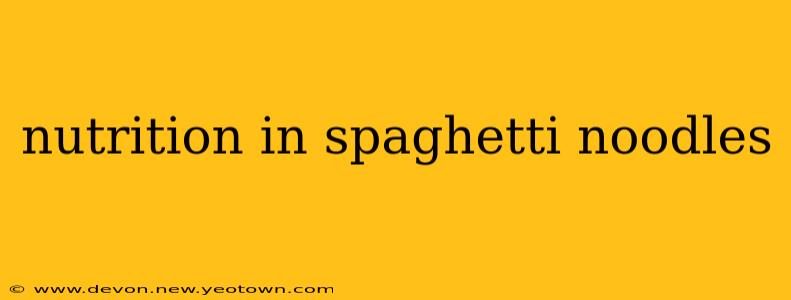Spaghetti, that beloved culinary staple, often conjures images of cozy family dinners and satisfying meals. But beyond its comforting presence, what's the true nutritional story behind those strands of pasta? Let's unravel the complexities of spaghetti noodles and explore their nutritional profile, addressing common questions along the way.
What are the main nutrients in spaghetti noodles?
Plain spaghetti noodles, before any sauces or additions, are primarily composed of carbohydrates. These carbs provide the body with energy. However, it's not just simple sugars; spaghetti also contains some protein and a small amount of fiber, primarily depending on the type of wheat used (more on that later!). The nutritional breakdown varies slightly depending on the brand and whether it's enriched or whole wheat, but you'll generally find a good source of iron and some B vitamins as well.
Is spaghetti high in calories?
Yes, spaghetti, like most pasta, is relatively high in calories. The calorie count depends on the serving size and the type of pasta, but a typical serving can range from 200 to 250 calories. It's important to remember that calorie density can increase significantly when you add sauces, cheese, and other toppings. Portion control is key to managing calorie intake when enjoying spaghetti.
What are the benefits of eating spaghetti?
While often viewed as a carb-heavy food, spaghetti does offer certain benefits. It's a readily available source of energy, perfect for fueling physical activity. The carbohydrates provide sustained energy, unlike sugary snacks that cause quick energy spikes followed by crashes. Furthermore, enriched spaghetti noodles are often fortified with iron and B vitamins, which are essential for various bodily functions. The fiber content, especially in whole wheat versions, aids digestion and contributes to feelings of fullness, potentially helping with weight management.
Is spaghetti good for weight loss?
This is a complex question. While spaghetti itself isn't inherently detrimental to weight loss, it's crucial to consider portion size and the ingredients added. A large serving of creamy, cheese-laden spaghetti will clearly hinder weight-loss efforts more than a smaller portion of whole wheat spaghetti with a simple tomato-based sauce and plenty of vegetables. Prioritizing whole wheat options, which are higher in fiber and therefore more filling, can also aid in weight management. The key is mindful eating and balanced meal planning.
What type of spaghetti is healthiest?
Whole wheat spaghetti is generally considered the healthiest option. Unlike refined white pasta, whole wheat retains more of the wheat grain's nutrients, including fiber. This added fiber not only promotes better digestion but also contributes to a greater feeling of satiety, reducing the likelihood of overeating. Look for options that clearly state "whole wheat" as the first ingredient.
Does the cooking method affect the nutrition in spaghetti?
Overcooking spaghetti can lead to a loss of some nutrients. It's best to cook it al dente, meaning "to the tooth," so that it's firm to the bite but not crunchy. This method helps retain more nutrients and texture. Also, avoid rinsing the cooked spaghetti with cold water, as this can wash away some of the water-soluble vitamins.
Is it better to eat spaghetti with or without sauce?
Both have their pros and cons. A simple tomato-based sauce can add lycopene (an antioxidant), vitamins, and fiber. However, creamy sauces and those loaded with cheese significantly increase the calorie and fat content. The healthiest approach lies in balancing the nutritional benefits of the sauce with the overall calorie and nutrient intake of the meal.
In conclusion, spaghetti noodles, while a source of carbohydrates, aren't inherently "bad" for you. By choosing whole wheat varieties, practicing mindful portion control, and adding nutrient-rich sauces and toppings, you can incorporate this beloved pasta into a balanced and healthy diet. The key is mindful consumption and making informed choices about the ingredients you add to your spaghetti dish.

